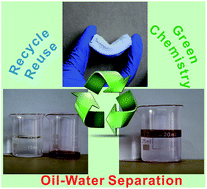Flexible superhydrophobic polysiloxane aerogels for oil–water separation via one-pot synthesis in supercritical CO2†
Abstract
Porous aerogels are an inspiring absorbent for oil–water separation and water purification. In particular, hydrophobic silica aerogels from abundant and cheap sources offer both economical and environmental benefits. Conventional silica aerogels from alkoxy siloxane precursors involve time-consuming and laboursome multistep processes. Herein, we demonstrate the formation of flexible superhydrophobic polysiloxane aerogels through a facile hydrosilylation from functionalized polydimethylsiloxane in supercritical carbon dioxide. This robust aerogel exhibits a high oil absorption capacity, superior recyclability and extraordinary mechanical properties even under harsh heating and cooling cycles. These characters favor this polysiloxane aerogel as being more competitive than common alkoxy silica ones for oily water treatment, oil spill clean-up and oil recovery.


 Please wait while we load your content...
Please wait while we load your content...